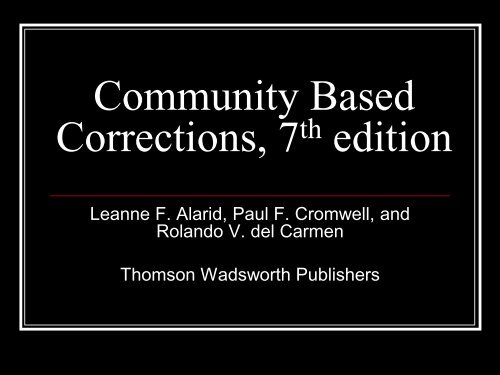Community Based Corrections, 7th edition - Peru State College
Community Based Corrections, 7th edition - Peru State College
Community Based Corrections, 7th edition - Peru State College
- No tags were found...
You also want an ePaper? Increase the reach of your titles
YUMPU automatically turns print PDFs into web optimized ePapers that Google loves.
<strong>Community</strong> <strong>Based</strong><strong>Corrections</strong>, 7 th <strong>edition</strong>Leanne F. Alarid, Paul F. Cromwell, andRolando V. del CarmenThomson Wadsworth Publishers
The Correctional Dilemma• Since the mid-1970’s, the public and politicianshave pursued “tough on crime” correctionalstrategies• Today, the United <strong>State</strong>s incarcerates the highestpercentage of convicted misdemeanants andfelons in the nation’s history• Nearly 7 million people are in jail, prison or onprobation or parole
The Correctional Dilemma, cont.• In the last decade, the corrections system hasincreased by 2.7% annually• The number of women offenders in all categoriescontinues to increase• The number of women on probation and parolehas doubled in the past 15 years
The rise in convicted offenders isdirectly related to four factors1. Changes in Sentencing Laws and LongerSentences for Violent Offenders2. Differential Police Responses to Drug Offenses3. Decreased Rate of Release on DiscretionaryParole4. Increase of Probation and Parole ViolatorsReturning to Prison
Changes in Sentencing Laws• Indeterminate sentencing was the primarysentencing philosophy from 1930’s to 1970’s andparole boards determined readiness for release• Support declined in the 1970’s due to questionsregarding rehabilitation and fairness of sentencing• Maine was the first state to adopt determinatesentencing in 1975
Changes in Sentencing Laws, cont.• Most states gradually adopted determinatesentencing structures that based the sentence onthe severity of the crime and the offender’scriminal history• Examples are mandatory minimums, truth insentencing, three strikes laws and sentencingguidelines• 16 states abolished parole as backdoor releasestrategy
Changes in Sentencing Laws, cont.• Federal sentencing guidelines are the mostcontroversial• <strong>State</strong> sentencing guidelines provide for morejudicial discretion• While discretionary parole rates have decreased,periods of mandatory release have increased• The pendulum may be swinging away fromconservative sentencing policies
The Toughening of JuvenileJustice• Most states have changed to model the adultsystem• Some juveniles are tried as adults automaticallyby type of crime or by discretion of the prosecutoror judge• Other areas, i.e., fingerprinting, opening records,opening court proceedings, etc. have becomemore like the adult system
The Toughening of JuvenileJustice, cont.• The Juvenile Justice system still exists separatelyfrom the adult system, with rehabilitation anddiversion as core missions• Most juvenile offenders are nonviolent and aretried in juvenile courts under a more informalprocess than adults
The Paradox• <strong>Corrections</strong> policy shifts as legislators perceivewhat the public wants• Public opinion polls often ask crime policyquestions in simplistic terms• The media often reports biased, sensationalistviews of crime and criminal justice• Consequently, the public is not well informed
Public Perceptions of <strong>Community</strong><strong>Corrections</strong>• 8 of 10 adults favored alternative programs fornon-violent offenders such as community service,mandatory education and job training 400 citizens• Pennsylvania citizens supported communitycorrections sentences for drug and propertyoffenders when restitution was a condition
Public Perceptions of <strong>Community</strong><strong>Corrections</strong>, cont.• Researchers found the public believedintermediate sanctions fit between prison andprobation with home detention, ISP and weekendsentences ranked from most to least severe• 400 Cincinnati residents were open to housearrest, halfway house placement or ISP for fourdifferent crime types when provided informationabout each offender
Public Perceptions of <strong>Community</strong><strong>Corrections</strong>, cont.• The public endorsed community-basedalternatives that would punish, restrain andchange offenders• The public has a low tolerance for failure of thosewho have been to prison• Public opinion supports use of community-basedcorrections and intermediate sanctions,particularly if treatment results in safercommunities
Correctional Budgets• Budgets for jails and prisons has significantlyincreased while some probation and parolebudgets have decreased• $36.1 billion was spent nationwide on state andfederal prisons, with a median of $368 million perstate, representing a 12% increase over four years
Correctional Budgets, cont.• $3.9 billion was spent on probation and paroleprograms nationwide, a decrease from $4.6 billionin 1999, with average budget per state of $82.9million• While 70% of all persons under correctionalsupervision are on probation and parole, theseprograms receive only 11% of the total budget
The Role of <strong>Corrections</strong> at ThreeMajor Decision Points• Discretion, or subjective decision making, in thecriminal justice system begins with victims andlaw enforcement• <strong>Community</strong> corrections is a sanction in whichoffenders serve some or all their sentence in thecommunity• A community sentence seeks to repair the harmthe offender has caused the victim or thecommunity
The Role of <strong>Corrections</strong> at ThreeMajor Decision Points, cont.• <strong>Community</strong>-based sanctions span a wide varietyof residential, economic and non-residentialtreatment options• Probation is the most common form and serves asthe base of community supervision• The American Probation and Parole Associationprovides professional training and standards forcommunity corrections
Pre-trial and the Bail Decision• Following arrest, a defendant is considered forrelease from custody• Bail often requires monetary payment depositedwith the court to ensure return, but manydefendants are released on their ownrecognizance• Pre-trial supervision is a form of correctionalsupervision that monitors the defendant’scompliance with bond conditions
Sentencing Decision• The vast majority of offenders can be punished inthe community• Intermediate sanctions offer graduated levels ofsupervision• A full range of sentencing options gives judgesgreater latitude to select punishments that moreclosely fit the crime and the offender
Reentry Decision• 95% of incarcerated prisoners will one day bereleased• Prisoner reentry is “conducted to prepare exconvictsto return safely to the community and tolive as law abiding citizens”• A prerelease program is a minimum securityinstitution for offenders nearing release• Programs such as halfway house, boot campsand therapeutic communities are examples ofback-end programs
Parole• Parole is the discretionary conditionalrelease of an offender prior to theexpiration of sentence• While technical differences exist betweenpretrial supervision, probation and parole,all involve supervision in the community
How <strong>Community</strong> <strong>Corrections</strong> FitsCorrectional Goals• <strong>Community</strong> corrections punishes offenderswhile protecting the public, addressingvictim needs and preventing future criminalbehavior though:• Rehabilitation• <strong>Community</strong> Reintegration• Restorative Justice• Shaming
Protection of the Public• A major criticism of traditional probation andparole has been the failure to protect the publicfrom future criminal acts• This criticism can be addressed in several ways:• Appropriate risk assessment must be utilized to selectappropriate offenders• The supervision of offenders should include propermonitoring of compliance with conditions• Violations of supervised conditions must be takenseriously
Rehabilitation• A goal of community corrections programs is tocorrect inadequacies that contribute to criminalbehavior• Typical problems encountered include drug oralcohol addiction, lack of emotional control,inadequate education or vocational training, lackof parenting skills, mental illness anddevelopmental disability
Rehabilitation, cont.• Correctional treatment or programming is themeans by which offenders receive assistance fortheir problems• The offender has to have the genuine desire tochange• Offenders who pose a serious danger to societyor themselves should not be in a communitycorrections program• Often offenders receive more treatment in thecommunity than in prison
Rehabilitation, cont.• <strong>Community</strong> based programming costs the taxpayer less because employed offenders pay forall or part of their treatment• <strong>Community</strong> based sanctions provide a means foroffenders who are not dangerous to repay theirvictims and the community
Rehabilitation, cont.• Proponents believe that if the issues related tocriminal behavior for certain offenders areaddressed, recidivism can be reduced between10 and 60%• The <strong>Corrections</strong> Program Assessment Inventory(CPAI) indicates that only 10-20% of allcorrectional treatment programs are “high quality”• The key is to replace ineffective programs withones that work
<strong>Community</strong> Reintegration• The 1967 President’s Commission on LawEnforcement and Administration of Justiceintroduced the term “reintegration”• Institutions isolate offenders physically andpsychologically• Reintegration stresses adaptation to thecommunity by requiring participation in programsthat develop accomplishments and the use ofskills in the community
Restorative or <strong>Community</strong> Justice• Restorative Justice is victim centered andemphasizes offender responsibility to repair theinjustice that offenders have caused their victims• When a crime is committed, the offender harmsboth the individual victim and the community• The offender must repair the damage byremaining in the community and repaying thevictim and the community at large
Public Shaming as Punishment• Some offenders can be deterred from future criminal conductby being publicly shamed• To be effective, shaming must have five conditions:• The offender must belong to an identifiable group• The form of shaming must be sufficient to compromise theperson’s social standing in the group• The punishment must be communicated to the community• The offender must fear being shunned• Normally, there must be a method for the offender to regainsocial status
The Effectiveness of <strong>Community</strong>-<strong>Based</strong> <strong>Corrections</strong>• “Evidence-based corrections” attempts tomeasure the process of a program and the impactit had on participants• Robert Martinson’s 1974 study of 231 correctionaltreatment programs concluded few had anappreciable effect on recidivism• Lipton, Martinson and Wilks reported reaching asimilar conclusion in 1975• Both studies set off a national debate on theeffectiveness of corrections
The Effectiveness of <strong>Community</strong>-<strong>Based</strong> <strong>Corrections</strong>, cont.• Martinson’s study coincided with a conservativeera of national politics when rehabilitativephilosophy was associated with liberal politics• Research methodology must be sophisticated andrigorous enough to determine what does and doesnot work• When evaluating effectiveness, treatment groupsmust be matched with control groups, which isdifficult to achieve with current sentencingpractices
The Effectiveness of <strong>Community</strong>-<strong>Based</strong> <strong>Corrections</strong>, cont.• Net widening is a common problem and occurs when anintermediate sanction is utilized unnecessarily in lieu of a lessrestrictive, and less costly, alternative• Evaluations of community service, ISP and boot camps reflectsimilar recidivism rates for new crimes as comparableoffenders receiving other sentences• Whether this is good or bad depends on whether theparticipants would have otherwise been in a less restrictiveprogram (probation) or more restrictive program (prison)
The Effectiveness of <strong>Community</strong>-<strong>Based</strong> <strong>Corrections</strong>, cont.• Recidivism, or the rate of recidivism, is the most commonform of measurement of program or treatment effectiveness• Recidivism is defined as repetition or return to criminalbehavior, measured by:• Rearrest,• Reconviction, or• Reincarceration• Different studies identify recidivism in different ways, makingcomparisons of effectiveness difficult
The Effectiveness of <strong>Community</strong>-<strong>Based</strong> <strong>Corrections</strong>, cont.• The effectiveness of community correctionsdepends on:• How recidivism is measured• Whether recidivism is measured only during periods ofsupervision• Whether recidivism rates are compared with rates ofoffenders of similar age and criminal history or with nocontrol group• Whether group assignment is random or quasiexperimental• If offenders would have received a lesser or greatersanction
The Effectiveness of <strong>Community</strong>-<strong>Based</strong> <strong>Corrections</strong>, cont.• Effectiveness might be measured indifferent ways:• Amount of restitution collected• Number of offenders employed• Amount of fines and fees collected• Number of community service hours• Number of probationers enrolled in school• Number of drug-free days• Impact on reduction of institutional crowding
















